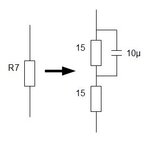Follow along with the video below to see how to install our site as a web app on your home screen.
Note: This feature may not be available in some browsers.

Really. How about IR receiver compatibility , is it capable to receive your transmitters carrier frequency.
You should also need to decrease the 47 ohm. Because with a rough calculation current on this line is (2 Volt forward for IR led) (12-2)/47 ~= 200 mA. Am i right?tryed mosfet, but with no luck, there is some more power to the IR diode, but i lost data transfer.